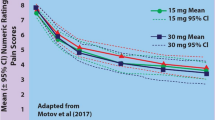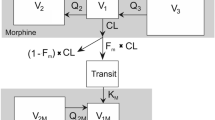Summary
Bone marrow transplant patients having severe, prolonged oral mucositis pain (expected to last for one to three weeks) used a computer-controlled infusion system to self-administer morphine for pain control. Individual patient pharmacokinetic information, derived from a pretreatment bolus morphine dose, was used in a new bolus-elimination transfer algorithm to produce rapid adjustments of steady plasma morphine concentrations when the patient requested more or less drug. We evaluated the performance characteristics (bias and precision) of this pharmacokinetically based patient-controlled analgesic infusion system (PKPCA) in a group of 15 cancer patients over six to 14 days.
Although we found a three- to fivefold pharmaco-kinetic variability in the tailoring morphine dose data, the PKPCA system was free of systematic bias (insignificant overall prediction error) during the patient-controlled infusions in this study population. The absolute prediction error was 19.9% for the group on the first study day and 25.6% over the entire study period (aggregate results; 6–14 days of continuous use). Two-thirds of the patients exhibited no bias throughout the study period, and individual bias in the others was symmetrically distributed (three patients with underpredictions and two overpredicted). Magnitude of prediction error during the patient-controlled morphine infusions was not related to the magnitude of pharmacokinetic deviation of individual subjects from group parameters.
Our results indicate that this PKPCA system provides accurate control of plasma morphine concentration when used by patients to self-administer opioid for prolonged pain relief continuously over 1 to 2 weeks. Use of individual pharmacokinetic information, instead of population parameters, may account for superior performance characteristic of this computer-assisted continuous drug infusion system.
Similar content being viewed by others
References
Aitkenhead AR, Vater M, Achola K, Cooper CMS, Smith G (1984) Pharmacokinetics of single dose IV morphine in normal volunteers and patients with end-stage renal failure. Br J Anaesth 56: 813–819
Alvis MJ, Reves JG, Govier AV, Menkhaus PG, Henling CE, Spain JA, Bradley E (1985) Computer-assisted continuous infusions of fentanyl during cardiac anesthesia: Comparison to a manual method. Anesthesiology 63: 41–49
Ausems ME, Stanski DR, Hug CC (1985) An evaluation of the accuracy of pharmacokinetic data for the computer-assisted infusion of alfentanil. Br J Anaesth 57: 1217–1225
Berkowitz BA, Ngai SH, Yang JC, Hempstead J, Spector S (1975) The disposition of morphine in surgical patients. Clin Pharmacol Ther 17: 629–635
Chapko MK, Syrjala KL, Schilter L, Cummings C, Sullivan K (1989) Chemoradiotherapy toxicity during bone marrow transplantation: Time course and variation in pain and nausea. Bone Marrow Transplant 4: 181–186
Chapman CR, Hill HF (1989) Prolonged morphine self-administration and addiction liability: Evaluation of two theories in a bone marrow transplant unit. Cancer 63: 1636–1655
Dahlstrom B, Tamsen A, Paalzow L, Hartvig P (1982) Patient-controlled analgesic therapy, Part IV Pharmacokinetics and analgesic plasma concentrations of morphine. Clin Pharmacokinet 7: 266–279
Gibaldi M, Perrier D (eds) (1982) Pharmacokinetics, 2nd ed. Dekker, New York
Glass PS, Jacobs JR, Smith LR, Ginsberg B, Quill TJ, Bai SA, Reves JG (1990) Pharmacokinetic model-driven infusion of fentanyl: Assessment of accuracy. Anesthesiology 73: 1082–1090
Gourlay GK, Cherry DA, Cousins MJ (19869 A comparative study of the efficacy and pharmacokinetics of oral methadone and morphine in the treatment of severe pain in patients with cancer. Pain 25: 297–312
Lehmann KA (1991) Patient controlled analgesia for postoperative pain relief: Issues in study design. In: Max M, Portenoy R, Laska E (eds) Design of Analgesic Clinical Trials. Raven Press, New York, pp 481–506
Graham MI, Shaw IC, Souhami RL, Sidau B, Harper PG, McLean AE (1983) Decreased plasma half-life of cyclophosphamide during repeated high-dose administration. Cancer Chemother Pharmacol 10: 192–193
Hand CW, Blunnie WP, Claffey LP, McShane AJ, McQuay HJ, Moore RA (1987) Potential analgesic contribution from morphine-6-glucuronide in CSR. Lancet 21: 1207–1208
Hill HF, Jacobson RC, Coda BA, Mackie AM (1991) A computerbased system for controlling plasma opioid concentrations according to patient need for analgesia. Clin Pharmacokinet 20: 319–330
Hill HF, Mackie AM, Coda BA, Iverson K, Chapman CR (1991a) Patient-controlled analgesic administration; a comparison of steady-state morphine infusions to bolus doses. Cancer 61: 813–882
Hill HF (1988) Pharmacokinetic tailoring of computer-controlled alfentanil infusions. In: Kroboth PD, Smith RB, Juhl RP (eds) Pharmacodynamic research: Current problems, potential solutions. Harvey Whitney, Cincinnati, pp 158–166
Hill HF, Chapman CR, Kornell J, Sullivan K, Saeger L, Benedetti C (1990a) Self-administration of morpine in bone marrow transplant patients reduces drug requirement. Pain 40: 121–129
Hill HF, Mackie AM, Jacobson R (1990b) Infusion-based patientcontrolled analgesia systems. In: Ferrante FM, Ostheimer GW, Covino BG (eds) Recent advances in patient-controlled analgesia. Blackwell, Oxford, pp 214–222
Hill HF, Saeger L, Bjurstrom R, Donaldsosn G, Chapman CR, Jacobson R (1990) Steady-state infusions of opioids inhuman volunteers: I. Pharmacokinetic tailoring. Pain 43: 57–67
Hill HF, Coda BA, Mackie AM, Iverson K, Barensten R (in press) Patient-controlled analgesic infusions: Alfentanil versus morphine. Pain
Inturrisi CE, Colburn WA (1986) Application of pharmacokinetic pharmacodynamic modeling to analgesia. In: Foley KM, Inturrisi CE (eds) Advances in pain research and therapy, vol 8. Raven Press, New York, pp 441–452
Kruger-Theimer E (1968) Continuous intravenous infusion and multicompartment accumulation. Eur J Clin Pharmacol 4: 317–324
McDonald GB, Sharma P, Matthews DE, Shulman HM, Thomas ED (1984) Venocclusive disease of the liver after bone marrow transplantation: Diagnosis, incidence, and predisposing factors. Hepatology 4: 116–122
Moore MJ, Hardy RW, Thiessen JJ, Soldin SJ, Erlichman C (1988) Rapid development of enhanced clearance after high-dose cyclophosphamide. Clin Pharmacol Ther 44: 622–628
Murphy MR, Hug CC Jr (1981) Pharmacokinetics of intravenous morphine in patients anesthetized with enflurane-nitrous oxide. Anesthesiology 54: 187–192
Osborne R, Joel S, Trew D, Slevin M (1990) Morphine and metabolite behavior after different routes of morphine administration: Demonstration of the importance of the active metabolite morphine-6-glucuronide. Clin Pharmacol Ther 47: 12–19
Owen JA, Sitar DS, Berger L, Brownell L, Duke PC, Mitenko PA (1983) Age-related morphine kinetics. Clin Pharmacol Ther 34: 364–368
Perry S, Inturrisi CE (1983) Analgesia and morphine disposition in burn patients. J Burn Care Rehab 4: 276–279
Sawe J (1986) Morphine and its 3- and 6-glucuronides in plasma and urine during chronic oral administration in cancer patients. In: Foley KM, Inturrisi CE (eds) Advances in pain research and therapy, Vol 8. Raven Press, New York, pp 45–56
Sawe J, Dahlstrom B, Paalzow L, Rane A (1981) Morphine kinetics in cancer patients. Clin Pharmacol Ther 30: 629–635
Sawe J, Kager L, Svennson Eng J-O, Rane A (1985) Oral morphine in cancer patients: In vivo kinetics and in vitro hepatic glucuronidation. Br J Clin Pharmacol 19: 495–501
Sawe J, Svensson JO, Rane A (1983) Morphine metabolism in cancer patients on increasing oral doses — no evidence for autoinduction or dose-dependence. Br J Clin Pharmacol 16: 85–93
Schuttler J, Schwilden H, Stoekel H (1983) Pharmacokinetics as applied to total intravenous anaesthesia: Practical applications. Anaesthesia 38: 53–56
Schwilden H (1981) A general method for calculating the dosage scheme in linear pharmacokinetics. Eur J Clin Pharmacol 20: 379–386
Schwilden H, Schuttler J, Stoekel H (1983) Pharmacokinetics as applied to total intravenous anaesthesia: Theoretical considerations. Anaesthesia 38: 51–52
Shafer SL, Varvel JR, Aziz N, Scott JC (1990) Pharmacokinetics of fentanyl administered by computer-controlled infusion pump. Anesthesiology 73: 1091–1102
Sheiner LM, Beal SL (1981) Some suggestions for measuring predictive performance. J Pharmacokinet Biopharm 9: 503–512
Stanski DR, Greenblatt DJ, Lappas DG, Koch-Wester J, Lowenstein E (1976) Kinetics of high-dose intravenous morphine in cardiac surgery patients. Clin Pharmacol Ther 19: 752–756
Stanski DR, Greenblatt DJ, Lowenstein E (1978) Kinetics of intravenous and intramuscular morphine. Clin Pharmacol Ther 24: 52–59
Todd RD, Muldoon SM, Watson RL (1982) Determination of morphine in cerebrospinal fluid and plasma by high performance liquid chromatography with electrochemical detection. J Chromatogr Biomed 232: 101–110
Vaughan DP, Tucker GT (1976) General derivation of the ideal intravenous drug input required to achieve and maintain a constant plasma drug concentration. Eur J Clin Pharmacol 10: 433–440
Yaksh TL, Onofrio BM (1987) Retrospective consideration of the doses of morphine given intrathecally by chronic infusion in 163 patients by 19 physicians. Pain 31: 211–223
Wilkinson GR, Shand DG (1975) Commentary: A physiological approach to hepatic drug clearance. Clin Pharmacol Ther 18: 377–390
Author information
Authors and Affiliations
Rights and permissions
About this article
Cite this article
Hill, H., Mackie, A., Coda, B. et al. Evaluation of the accuracy of a pharmacokinetically-based patient-controlled analgesia system. Eur J Clin Pharmacol 43, 67–75 (1992). https://doi.org/10.1007/BF02280757
Received:
Accepted:
Issue Date:
DOI: https://doi.org/10.1007/BF02280757




